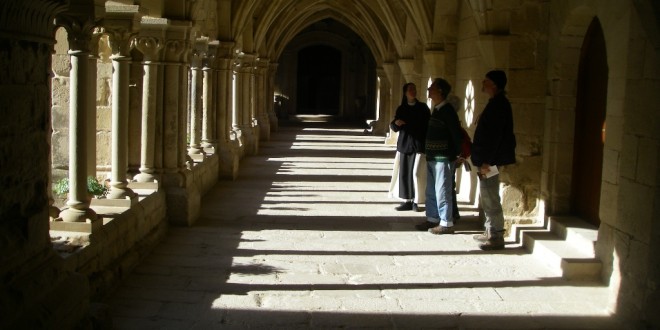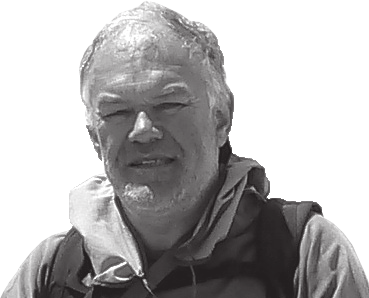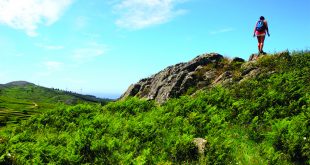Twenty steps lead up to the second floor of the sandstone stronghold that stands behind metre-thick walls. That’s where the five guest cells of the Catalonian Cistercian monastery Poblet are to be found. Brother Paco, aged 79, alias Francisco Martínez Soria, hands me the key. He shows me the bathroom, broom cupboard and the wall-walk around the monastery. He’s a man of few words: “Singing at one, followed by lunch.” Then he leaves. Bed, desk, chair, shelf, rubbish bin, saint’s image, radiator, desk lamp. Four by two-and-a-half metres. This is where the three-day, 106 km long walk along the Cistercian Route begins. I make my bed, lie down and stare at the ceiling. Mobile phone turned off, laptop left at home. With just a map, a notebook and a pen, I prepare for the walk. We’re setting off early the next day. The tour links three historical sites: the Poblet monastery with its sister monastery Vallbona de les Monges and Santes Creus in the province of Tarragona near Barcelona.
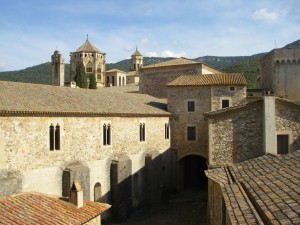
At 4.45, a shrill bell wakes us up. At 5, the peal of bells makes the walls tremble. Then the monks pour into the cathedral pews for early morning prayers. A bow before the altar and the alabaster altarpiece, which was built before the Renaissance. Tourists are admitted between 10 and 1, and 3 and 6. Then there’s a lot of talking again. For the remaining 18 hours of the day, the monastery belongs to the silence of its 33 venerable occupants. After lunch, my notebook and pen help me to record a strange conversation with Brother Paco. In the refectory, the abbot José Alegre Vilas is meanwhile standing with his cross over his habit, saying the midday prayer. The monks stand in front of the tables and wait until he gives the word. Broad beans with onions and bacon, breaded pork with chips, cherries for dessert.
No one speaks, except for the monk who’s reading aloud. The monks sit at table with their backs to the wall, engrossed in the meal and in the news from the reader. The bottle of red house wine is just as much a part of it as the monastery’s own spring water. On World Recycling Day, the monk reads out the worldly news from a newspaper from a small recess in the upper wall. The words “paradigm shift” crop up, alongside others such as “circular economy” and “careful use of resources”. Is this just a pious hope? After 15 minutes, the abbot cuts the reader short. Lunch is over. I just have time to fold my cloth napkin and join the line.
On the way back to my cell, I meet Brother Paco. We walk out of the Cloister of Silence through a gate into a dark corner where we sit down and talk quietly. We avoid topics like the inquisition, the burning of Jews and the banishment of the Moors, and the many other crimes committed by the Catholic Church over the centuries. What I want to know is what the monks do all day long, if anything, apart from investing their energy in prayer and song at the least auspicious times of the day.
Did they have particular jobs? I learn that there is a library, a sick bay with pharmacy, a kitchen, a laundry and some other jobs to pay homage to worldly matters: studying, healing, cooking, washing and cleaning. Did celibacy mean that no women visitors were allowed into the monastery, I wanted to know. Apart from one seamstress, no other women ever got behind the thick monastery walls, Brother Paco assured me. What did they live from? Working in the fields?
This was wide of the mark. Apart from a few vegetables, nothing is grown any more in the monastery. “Without tourists, the monastery would be broke in three weeks,” said Brother Paco resignedly. They sold entrance tickets, souvenirs, books and ran a hotel and a restaurant. The wine might bear the name of the monastery, but it was made by a big Spanish wine and champagne producer. No, I wasn’t a Catholic, I replied to the smiling monk.
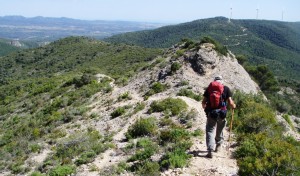 The next morning, the 25 km walk begins, taking us from the monks’ strict regime to the small town of L’Espluga de Francoli, two kilometres away. There we buy supplies for the coming days. We cross the AP-2 motorway and are taken by surprise as a small footpath leads us through wheat fields and swallows us up. The hikers walk along the GR 175 as far as the climb into the Serra del Tallat. At some stage, those who have baguettes and goat’s cheese, fruit and chocolate with them, make themselves comfortable at the edge of the wood and savour the beautiful view over the snow-covered Pyrenees. After walking for six hours through pine groves, holm oaks and medronho bushes, the monastery of Vallbona de les Monges comes into view. Here too, centuries-old Catholic culture can be found hewn into stone. The last nine sisters there complain about the lack of new blood.
The next morning, the 25 km walk begins, taking us from the monks’ strict regime to the small town of L’Espluga de Francoli, two kilometres away. There we buy supplies for the coming days. We cross the AP-2 motorway and are taken by surprise as a small footpath leads us through wheat fields and swallows us up. The hikers walk along the GR 175 as far as the climb into the Serra del Tallat. At some stage, those who have baguettes and goat’s cheese, fruit and chocolate with them, make themselves comfortable at the edge of the wood and savour the beautiful view over the snow-covered Pyrenees. After walking for six hours through pine groves, holm oaks and medronho bushes, the monastery of Vallbona de les Monges comes into view. Here too, centuries-old Catholic culture can be found hewn into stone. The last nine sisters there complain about the lack of new blood.
The second day of the hike begins at six o’clock: we have 45 km ahead of us. In 1938, parts of the route were the second Republican front line during the Spanish Civil War. After ten kilometres, we have breakfast at the café in the village of Rocallaura. We pass through Belltall, Forès and Rocafort de Queralt on our way to Montbrio de la Marca. Well-marked tracks and short stretches of tarred road bring us closer to lunch at the restaurant El Celler. We’ve managed 25 kilometres, which would actually have been enough. But now we have a one-hour climb up to the 800 metre high Puig de Comaverd with a spectacular view over the Mediterranean. We abseil from the summit down to the ridge and then climb down el Cogulló. For the next few kilometres, there’s a drop of a few hundred metres to the left and right of the path. With wind force 6 to 8, that requires a high degree of concentration. It’s another ten kilometres through Pont d´Armentera to Santes Creus. We arrive at nine in the evening. The monastery is being restored. We sleep at the Hostal Grau at the foot of the 800-year-old monument.
The third day provides us with 36 kilometres of the most beautiful hiking trails. We set off at 10 in the morning. As far as el Pla de Santa Maria, you walk along narrow paths through fields of wheat and vineyards, and then through raspberry fields. Just three kilometres away, Figuerola del Camp is already in sight. The climb up into the Serra de Jordà begins on the hillside there. There’s time to replenish your water bottle at the village spring, and then you start climbing. On the way down later on, hikers can fill their bottles up at the Font de San Salvador. From Prenafeta, it’s easy to get to Montblanc. A second ascent up to Sant Joan indicates that the end of the walk is not far off. With a close look at the map, those who have so far husbanded their energy reserves will know that there is still a third climb to come, to the Coll de la Vena. All the peaks in the secondary chain are between 700 and 900 metres in height.
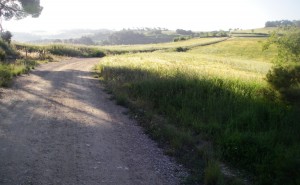 Towards 8 o’clock in the evening, walkers arrive back at the Poblet monastery. With a large key, Brother Paco opens the gate where you swap your freedom for quiet and solitude. People who are looking for God and the requisite solitude are also free to do so outside the monastery walls. In the natural world, between the ears of wheat swaying in the wind and the vines stretching away into the distance, God can also appear to you, boundlessly.
Towards 8 o’clock in the evening, walkers arrive back at the Poblet monastery. With a large key, Brother Paco opens the gate where you swap your freedom for quiet and solitude. People who are looking for God and the requisite solitude are also free to do so outside the monastery walls. In the natural world, between the ears of wheat swaying in the wind and the vines stretching away into the distance, God can also appear to you, boundlessly.
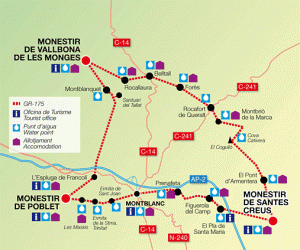 Get there by train (CP/RENFE) from Lisbon via Madrid to L’Espluga de Francoli (direction of Barcelona)
Get there by train (CP/RENFE) from Lisbon via Madrid to L’Espluga de Francoli (direction of Barcelona)Sector Poblet – Vallbona de les Monges, 25 km • Duration of the walk: 6 hours
overnight at the monastery
Tel. 0034/973 330 266 or 618 876 004
picnic lunch
Sector Vallbona de les Monges – Santes Creus, 45 km • Duration of the walk: 12 hours
lunch at the restaurant El Celler in Montbrió de la Marca
Tel. 0034/977 898 172 or 687 979 197
overnight e.g. at the Hostal Grau 0034/977 638 311
Sector Santes Creus – Poblet, 36 km • Duration of the walk: 10 hours
overnight at the monastery/guest house
Tel. 0034/977 871 201
picnic lunch
Covering 106 km in three days is not something that all walkers will find easy. Less experienced walkers can also do the walk in five days, as there are places to stay in Montbrio de la Marca and Montblanc.
All in all, the waymarking is mainly good and well produced, the footpaths are well maintained, the route’s cultural and historical themes are interesting, and the degree of difficulty is manageable, often with beautiful, shady and narrow steep paths. The secluded natural landscape of the mountains, especially on the second and third days, is mostly very impressive.
 Eco123 Revista da Economia e Ecologia
Eco123 Revista da Economia e Ecologia

